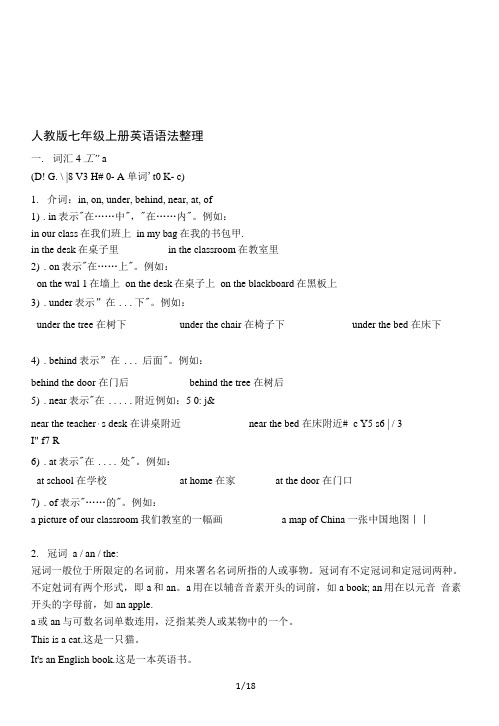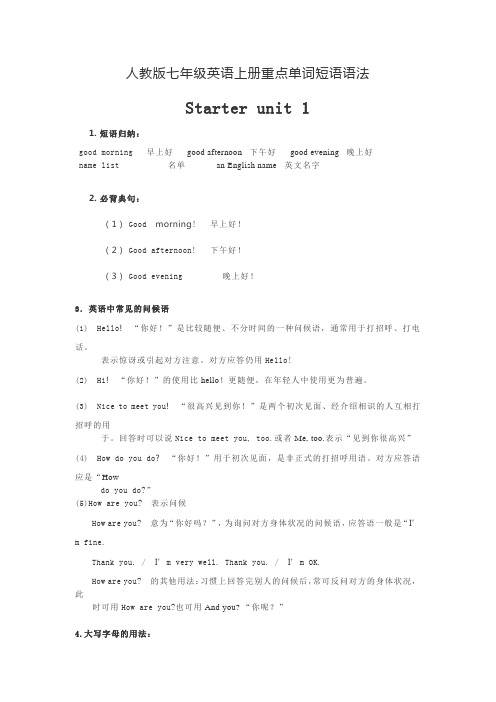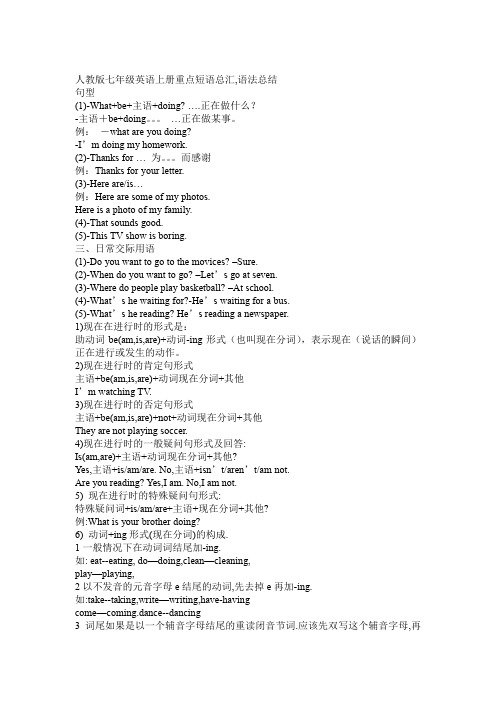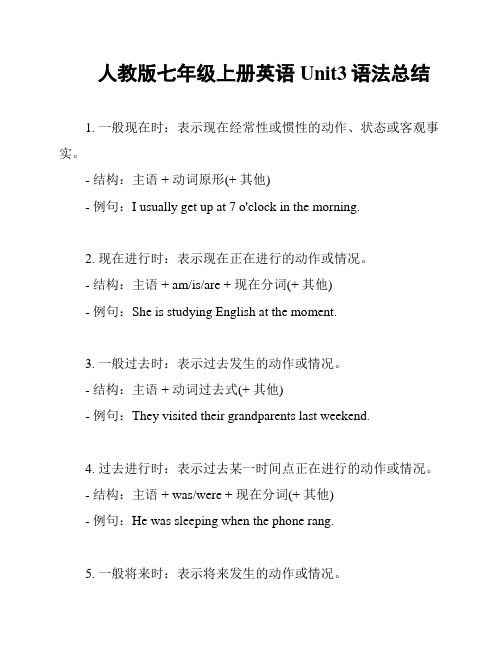七年级上册英语语法大全(整理版)
- 格式:doc
- 大小:84.00 KB
- 文档页数:10

第一讲:动词一.Be 动词(am, is, are)的用法口诀:I 用 am , you 用 are ,is 连着他(he)她(she)它(it)。
单数全部用 is,复数一律都用 are. 变疑问,往前提,句末问号莫丢弃,变否定,更容易,be 后 not 莫忘记,句首大写莫迟疑。
I a student. You Japanese.He my brother. She very nice.My name Harry. LiLei very tall.This book very interesting. Li Lei and I good friends.These apples. Those bananas.They students. There some bread on the plate.The cat black. The black pants for Su Yang.Here some sweaters for you. There a girl in the room.There some milk for me. There some apples on the tree.Gao Shan's shirt over there. Some tea in the glass.二.一般现在时态1.用法:(1).表示习惯性,经常性的动作,常与o f t e n,a l w a y s,u s u a ll y,e v e r y d a y/w ee k/m o n t h…等词连用I o f t e n p l a y s o cc e r.(2).表示主语具备的性格或能力:H e li k e s t o e a t b a n a n a s.2.在一般现在时态中,当主语是第三人称单数时,谓语动词也用第三人称单数, 第三人称单数的构成规则(主语不是第三人称单数时谓语动词用原形):a.一般情况下在动词词尾加 s 如:get----gets like----likes play—plays, want—wants,work—works,b.以字母 s、x、ch, sh,o 结尾的动词加-es:guess—guesses, fix—fixes, teach—teaches,brush—brushes, go—goes,c.以辅音字母+y 结尾的动词,先变y 为i,再加-es:study—studies,carry—carries,fly—flies,特殊词: have --- has一写出下列动词的三单形式。

人教版七年级上册英语语法整理一. 词汇4工” a(D! G. \ |8 V3 H# 0- A 单词't0 K- c)1.介词:in, on, under, behind, near, at, of1). in表示"在……中","在……内"。
例如:in our class在我们班上in my bag在我的书包甲.in the desk在桌子里in the classroom在教室里2). on表示"在……上"。
例如:on the wal 1在墙上on the desk在桌子上on the blackboard在黑板上3). under表示”在...下"。
例如:under the tree 在树下under the chair 在椅子下under the bed 在床下4). behind表示”在 ... 后面"。
例如:behind the door 在门后behind the tree 在树后5). near表示"在 .....附近例如:5 0: j&near the teacher,s desk 在讲桌附近near the bed 在床附近# c Y5 s6 | / 3I" f7 R6). at表示"在.... 处"。
例如:at school 在学校at home 在家at the door 在门口7). of表示"……的"。
例如:a picture of our classroom我们教室的一幅画 a map of China 一张中国地图丨丨2.冠词a / an / the:冠词一般位于所限定的名词前,用來署名名词所指的人或事物。
冠词有不定冠词和定冠词两种。
不定尅词有两个形式,即a和an。
a用在以辅音音素开头的词前,如a book; an用在以元音音素开头的字母前,如an apple.a或an与可数名词单数连用,泛指某类人或某物中的一个。

人教版七年级英语上册重点单词短语语法Starter unit 11. 短语归纳:good morning 早上好good afternoon 下午好good evening 晚上好name list 名单an English name 英文名字2. 必背典句:(1)Good morning! 早上好!(2)Good afternoon! 下午好!(3)Good evening 晚上好!3.英语中常见的问候语(1) Hello!“你好!”是比较随便、不分时间的一种问候语,通常用于打招呼、打电话。
表示惊讶或引起对方注意。
对方应答仍用Hello!(2) Hi!“你好!”的使用比hello!更随便,在年轻人中使用更为普遍。
(3) Nice to meet you!“很高兴见到你!”是两个初次见面、经介绍相识的人互相打招呼的用于。
回答时可以说Nice to meet you, too.或者Me, too.表示“见到你很高兴”(4) How do you do?“你好!”用于初次见面,是非正式的打招呼用语。
对方应答语应是“Howdo you do?”(5)How are you? 表示问候How are you? 意为“你好吗?”,为询问对方身体状况的问候语,应答语一般是“I’m fine.Thank you. / I’m very well. Thank you. / I’m OK.How are you? 的其他用法:习惯上回答完别人的问候后,常可反问对方的身体状况,此时可用How are you?也可用And you? “你呢?”4.大写字母的用法:(1) 在英语中,句子的第一个单词的第一个字母都应大写。
Sit down, please. 请坐。
(2)字母I作人称代词时,意为“我”,在句中任何位置都必须大写。
日常用语“OK”在句中任何位置都大写。
I’m a student. 我是一名学生。
Is everything OK? 一切都好吗?(3)人名、地名、国名、某国人或某种语言等专有名词的第一个字母都必须大写。

人教版七年级英语上册重点短语总汇,语法总结句型(1)-What+be+主语+doing? ….正在做什么?-主语+be+doing。
…正在做某事。
例:-what are you doing?-I’m doing my homework.(2)-Thanks for … 为。
而感谢例:Thanks for your letter.(3)-Here are/is…例:Here are some of my photos.Here is a photo of my family.(4)-That sounds good.(5)-This TV show is boring.三、日常交际用语(1)-Do you want to go to the movices? –Sure.(2)-When do you want to go? –Let’s go at seven.(3)-Where do people play basketball? –At school.(4)-What’s he waiting for?-He’s waiting for a bus.(5)-What’s he reading? He’s reading a newspaper.1)现在在进行时的形式是:助动词be(am,is,are)+动词-ing形式(也叫现在分词),表示现在(说话的瞬间)正在进行或发生的动作。
2)现在进行时的肯定句形式主语+be(am,is,are)+动词现在分词+其他I’m watching TV.3)现在进行时的否定句形式主语+be(am,is,are)+not+动词现在分词+其他They are not playing soccer.4)现在进行时的一般疑问句形式及回答:Is(am,are)+主语+动词现在分词+其他?Yes,主语+is/am/are. No,主语+isn’t/aren’t/am not.Are you reading? Yes,I am. No,I am not.5) 现在进行时的特殊疑问句形式:特殊疑问词+is/am/are+主语+现在分词+其他?例:What is your brother doing?6) 动词+ing形式(现在分词)的构成.1一般情况下在动词词结尾加-ing.如: eat--eating, do—doing,clean—cleaning,play—playing,2以不发音的元音字母e结尾的动词,先去掉e再加-ing.如:take--taking,write—writing,have-havingcome—coming.dance--dancing3词尾如果是以一个辅音字母结尾的重读闭音节词.应该先双写这个辅音字母,再加-ing.如:run—runing,sit—sitting ,swim—swimming.Shop—shopping.put—putting,sit—sittingUnit 6 It’s raning!一、词组Around The World 世界各地On vacation 度假Take photos 拍照On the beach 在海边a group of people 一群人play beach volleyball 打沙滩排球be surprised 惊讶的be surprised at sth./sb.对某人或某人感到惊讶be relaxed 放松have a good time 玩得很痛快in different kind of weather 在不同的天气里Thank sb for(doing)sth由于(做)某事而感谢某人How’s it going? 近况如何Some…others…一些…另一些…Look like..看起来像。

七年级上册英语语法总汇.动词 be ( is,am,are )的用法数名词全用 are 。
变否定,更容易, 还有一条须注意,句首大写莫忘记。
二. this , that 和 it 用法(1) this 和 that 是指示代词, it 是人称代词。
(2) 距离说话人近的人或物用 this, 距离说话人远的人或物用 that 。
如:This is a flower. 这是一朵花。
( 近处 )( 远处 ) this, 后说 that 。
如:这是一支钢笔。
那是一支铅笔。
不说 That is …。
如:这是海伦,海伦,这是汤姆。
可以缩写。
如: 这是一辆自行车。
那是一辆轿车。
(6) 打电话时,介绍自己用 this, 询问对方用 that 。
如:—Hello! Is that Miss Green? 喂,是格林小姐吗? —Yes, this is. Who's that? 是的,我是,你是谁?注意:虽然汉语中使用“我”和“你”,但英语中打电话时绝不可以说: I am …, Areyou …? /Who are you?(7) 在回答 this 或 that 作主语的疑问句时 , 要用 it 代替 this 或 that 。
如: ① — Is this a notebook? 这是笔记本吗? —Yes, it is.是的,它是。
② — What 's that? 那是什么? —It 's a kite. 是只风筝。
我(I)用 am, 你 (you) 用 are ,is 跟着他(he),她(she),它(it) 。
单数名词用 is ,复be 后 not 加上去。
变疑问,往前提,句末问号莫丢弃。
That is a tree. 那是一棵树。
(3) 放在一起的两样东西,先说 This is a pen. That is a pencil. (4) 向别人介绍某人时说 This is This is Helen. Helen, this is Tom. (5) This is 不能缩写 , 而That isthese 和those 用法和those 是指示代词,these 是this 的复数形式,指时间,距离较近的或下面要提到的人或事;those 是that 的复数形式,指时间、距离较远或前面已经提到过的人或事物。

七年级英语语法知识点归纳总结上册一、名词。
1. 名词的分类。
- 专有名词:表示特定的人、地方、组织等,首字母大写,如China(中国),Tom(汤姆)。
- 普通名词:- 可数名词:有单复数形式,如book(书,单数),books(复数)。
- 不可数名词:没有复数形式,如water(水),milk(牛奶)。
2. 可数名词复数的变化规则。
- 一般情况加 -s,如pen - pens,desk - desks。
- 以s, x, ch, sh结尾的加 -es,如bus - buses,box - boxes,watch - watches,brush - brushes。
- 以辅音字母 + y结尾的,变y为i加 -es,如baby - babies。
- 以f或fe结尾的,变f或fe为v加 -es,如knife - knives,leaf - leaves(但也有一些直接加 -s的,如roof - roofs)。
- 不规则变化,如man - men,woman - women,child - children,foot - feet,tooth - teeth。
3. 名词所有格。
- 有生命的名词所有格:- 一般在名词后加's,如Tom's book(汤姆的书)。
- 以s结尾的复数名词,只加',如the students' classroom(学生们的教室)。
- 表示两者共有时,在后一个名词后加's,如Lucy and Lily's mother(露西和莉莉的妈妈);表示各自拥有时,在每个名词后加's,如Lucy's and Lily's bags (露西的包和莉莉的包)。
- 无生命的名词所有格,用“of+名词”结构,如the window of the room(房间的窗户)。
二、代词。
1. 人称代词。
- 主格:I(我),you(你/你们),he(他),she(她),it(它),we(我们),they(他们/她们/它们),在句中作主语,如I like English.(我喜欢英语)。

7年级上册语法总结Unit 1动词be的一般现在时1、表示一种事实:He is 11 years old他. 11 岁了。
I am from China.我来自中国。
2、表示一种状态〔经常存在〕:He goes fishing every weekend他.每个周末都去垂钓。
We usually go to school at 7:00我.们平时 7 点上学。
3、Be 动词与主语保持一致:I am a teacher.He/She is a worker. It is a little dog.They/We/You are dancers.Be 动词变化依据原那么,口诀:我是 am,你是 are,is 用于他、她、它 , 复数都是 are.4、主语是第三人称单数时,动词的变化:一般都 +s比方:open opens以sss结尾的动词, +es比方:watch watches xshch辅音字母 +y 结尾的动词, y ies比方:study studies④辅音字母 +o 结尾的动词, +es比方:go goes5、一般现在时的句型变换否认句 be+notShe is in the kitchen.~She is not in the kitchen.They are in the classroom.~Theyare not in the classroom.一般疑问句 be 提前She is in the kitchen.~Is she in the kitchen?—— Yes,she is.—— No,she isn’t.They are in the classroom.~Are they in the classroom?—— Yes,they are.—— No,they aren’t.Unit 2行为动词的一般现在时用法例句I go to school at 7:00 every morning.经常性、习惯性的动作The earth moves around the sun客观事实目前的爱好、能力等She sings very well.1、行为动词形式变化主语行为动词第一人称复数〔we〕/第二人称复原形数〔you〕/第三人称复数〔They〕例句We do our homeworkat home.You have lunch at school. They play basketball after school.第三人称单数〔 He、She、It 〕2、句型变换否认句: do+not/does +not 第三人称单She does her 数homework in theevening.You don’tgo to school on Sunday.He doesn’twork in this shop.句首增加 do/doesDo you play basketball after school?Does John speak Chinese?Unit 3人称代词1、我们常用人称代词表示人或物2、人称代词主格、宾格形式单数复数主格宾格主格宾格第一人称I Me We Us第二人称You You You YouHe Him They Them 第三人称She HerIt It3、主格在句中做主语,一般用在动词前宾格在句中做宾语,一般用在动词、介词后4、有好几个人称代词并列出现时,序次以下:单数: 231 原那么—— you、he and I复数: 123 原那么—— we、you and theyUnit 4表示时间的介词 in、on、at介词用法例子in一天中的早 /中/晚 In the morning/afternoon/evening月份In January/February/March/April季节In Spring/Summer/Autumn/Winter年份In 2021/2021on星期On Sunday/Monday/Tuesday某一天On 1 September某一天的早 /中/晚 On a cold morning/Sunday afternoon特定节日 /一天On Children’s Dayat某一时辰At 8:00年龄At 12 years old频度副词:always>usually>often>sometimes>seldom>neverUnit 5特别疑问句特别疑问词含义例句what什么What‘s your name?Class/grade哪个班级、年级What class/grade are you in? what colour什么颜色What colour do you like?time几点What time is it?when什么时候When do you usually get up? where哪里Where do you live?who谁Who is the man in a blue sweater?why为什么Why are you always late for school?whose谁的Whose pen is this?which哪一个Which is better,the red one or the blue one?how怎么样How do you go to school?many多少〔可数〕How many students are there in your class?much多少〔不能数〕How much milk do you drinkevery day?old几岁How old are you?how often多长时间一次How often do you go to the library?long多长How long is the Yangtze River?多久How long do you watch TVevery day?far多远How far is your home from school?tall多高How tall is the building?注意: when 和 what time 的差异What time 咨询的是详尽时间, when 能够是详尽时间也能够是大体时间。

人教版最全的七年级上册英语语法1.一般现在时:主语+do/does(现在分词) We clean the room every day.一般现在时:do(n't)/does(n't)2.一般过去时:主语+did We cleaned the room just now.一般过去式:did(n't)+V.原3.现在进行时:主语+am/is/are doing We are cleaning the room now.现在进行时:am(not)/is(n't)/are(n't)+V.ing4.过去进行时:was/were doing .We were cheaning the room at 5:00 yesterday afternoon.过去进行时:was(n't)/were(n't)+V.ing5.现在完成时: have/has done We have cleaned the room already.现在完成时:have(n't)/has(n't)+过去分词(p.p.)6.过去完成时: had done We had cleaned the room before he arrived.过去完成时:had+p.p.7.一般将来时: will do/ We will clean the room tomorrow.一般将来时:will(not)+V.ing / is(n't)/are(n't)+going to +V.原8.过去将来时: was/were to /would do He said he would clean the room next过去将来时:would(n't) / was(n't)/were(n't)+V.原动词不定式:to+V.ing一、一般现在时:概念:经常、反复发生的动作或行为及现在的某种状况。

人教版七年级上册英语Unit3语法总结1. 一般现在时:表示现在经常性或惯性的动作、状态或客观事实。
- 结构:主语 + 动词原形(+ 其他)- 例句:I usually get up at 7 o'clock in the morning.2. 现在进行时:表示现在正在进行的动作或情况。
- 结构:主语 + am/is/are + 现在分词(+ 其他)- 例句:She is studying English at the moment.3. 一般过去时:表示过去发生的动作或情况。
- 结构:主语 + 动词过去式(+ 其他)- 例句:They visited their grandparents last weekend.4. 过去进行时:表示过去某一时间点正在进行的动作或情况。
- 结构:主语 + was/were + 现在分词(+ 其他)- 例句:He was sleeping when the phone rang.5. 一般将来时:表示将来发生的动作或情况。
- 结构:主语 + will + 动词原形(+ 其他)- 例句:I will go to the park tomorrow.6. 能力和意愿:can,could,may,might,must,shall,should,would等。
- 例句:You should finish your homework before going out.7. 祈使句:表示命令、请求、建议、劝告或禁止等。
- 结构:动词原形(+ 其他)- 例句:Please pass me the book.8. 直接引语和间接引语:表示他人的陈述、断言或问句等。
- 结构:直接引语:引号内的内容;间接引语:引号外的内容。
- 例句:- 直接引语:He said, "I am studying English."- 间接引语:He said that he was studying English.以上是人教版七年级上册英语Unit3语法总结,供参考。

七年级上册英语语法1.介词:in, on, under, behind, near, at, of1). in表示"在……中", "在……内"。
例如: in our class 在我们班上 in my bag 在我的书包里 in the desk 在桌子里 in the classroom 在教室里2). on blackboard 在黑板上3). under表示"在……下"。
例如: under the tree 在树下 under the chair 在椅子下 under the bed 在床上4). behind表示"在……后面"。
例如: behind the door 在门后 behind the tree 在树后5). near表示"在……附近"。
例如: near the teacher's desk 在讲桌附近 near the bed 在床附近6). at表示"在……处"。
例如: at school 在学校 at home 在家 at the door 在门口7). of 表示"……的"。
例如: a picture of our classroom 我们教室的一幅画 a map of China 一张中国地图2.冠词 a / an / the: 冠词一般位于所限定的名词前,用来署名名词所指的人或事物。
冠词有不定冠词和定冠词两种。
1)不定冠词有两个形式,即a和an。
a用在以辅音音素开头的词前,如a book; an用在以元音音素开头的字母前,如an apple. a或an与可数名词单数连用,泛指某类人或某物中的一个。
This is a cat. 这是一只猫。
It's an English book. 这是一本英语书。
His father is a worker. 他的爸爸是个工人。

苏教版七年级上册英语语法一. 词汇⑴单词1. 介词:in, on, under, behind, near, at, of1). in表示"在……中","在……内"。
例如:in our class 在我们班上in my bag 在我的书包里in the desk 在桌子里in the classroom 在教室里2). on 表示"在……上"。
例如:on the wall 在墙上on the desk 在桌子上on the blackboard 在黑板上3). under表示"在……下"。
例如:under the tree 在树下under the chair 在椅子下under the bed 在床下4). behind表示"在……后面"。
例如:behind the door 在门后behind the tree 在树后5). near表示"在……附近"。
例如:near the teacher's desk 在讲桌附近near the bed 在床附近6). at表示"在……处"。
例如:at school 在学校at home 在家at the door 在门口7). of 表示"……的"。
例如:a picture of our classroom 我们教室的一幅画a map of China 一张中国地图2. 冠词a / an / the:冠词一般位于所限定的名词前,用来署名名词所指的人或事物。
冠词有不定冠词和定冠词两种。
不定冠词有两个形式,即a和an。
a用在以辅音音素开头的词前,如a book; an用在以元音音素开头的字母前,如an apple. a或an与可数名词单数连用,泛指某类人或某物中的一个。
This is a cat.这是一只猫。
![(完整)[初一英语]新人教版七年级上册全册语法总结,推荐文档](https://img.taocdn.com/s1/m/680433e13968011ca200910c.png)
七年级上册语法总结一、词类二、名词1.名词:表示人或事物的名称1)总的来说,名词分为专有名词和普通名词两类。
专有名词时个别的人、事物、地点等专有的名称,如:Gina, China 等专有名词,专有名词第一个字母要大写。
2)名词按其所表示事物的性质分为可数名词和不可数名词。
可数名词(Countable Nouns)有复数形式,如:an apple, two apples。
不可数名词(Uncountable Nouns)一般没有复数形式,如:broccoli。
3)可数名词有单数(Singular Form)和复数(Plural Form)两种形式,以下介绍可数名词复数形式变化规则:*本册出现的不可数名词有:broccoli*既可数又不可数名词有:ice cream,salad,chicken2.名词所有格表示所属关系的一种格式1)-’s 所有格大多数表示有生命的名词的所有格名词,加-’s表示为各自所有的各个名词后都要变化,分别加-’sTom’s and Lucy’s books2)无生命的名词的所有格,一般由“名词+of+名词”构成Eg:a map of China 一副中国地图the capital of America 美国的首都*双重所有格由“名词+of+-’s”或“名词+of+名词性物主代词”构成Eg:a friend of my mother’s一个我妈妈的朋友a friend of theirs/his/hers/ours三、代词1.含义:代词是代替名词以及起名词作用的短语、不定式、V-ing 形式、从句或整个句子的词。
2.代词的分类(本书涉及三类代词):1).指示代词表示“这个”、“那个”、“这些”、“那些”等指示概念的代词单数复数用法例句this these 一般用来指时间或空间上较近的事物Is this your pencil?These are my pens.that those 一般用来指时间后空间上较远的事物Is that you grandfather?Those are his brothers.2)人称代词代指人或事物,在句中作主语或宾语,所以有主格和宾格形式人称单数复数主格宾格主格宾格第一人称I me we us第二人称you you you you第三人称he himthey themshe herit it3)物主代词表示所有关系的单词,是人称代词的属格形式。

七年级英语上册知识点梳理(重点语法)七年级上册英语语法.动词be(is,a,are)的用法我用a,你用are,is跟着他,她,它。
单数名词用is,复数名词全用are。
变否定,更容易,be后nt加上去。
变疑问,往前提,句末问号莫丢弃。
还有一条须注意,句首大写莫忘记。
2.this,that和it用法this和that是指示代词,it是人称代词。
距离说话人近的人或物用this,距离说话人远的人或物用that。
如:Thisisafler这是一朵花。
Thatisatree那是一棵树。
放在一起的两样东西,先说this,后说that。
如:ThisisapenThatisapenil这是一支钢笔。
那是一支铅笔。
向别人介绍某人时说Thisis…,不说Thatis…。
如:ThisisHelenHelen,thisisT这是海伦,海伦,这是汤姆。
Thisis不能缩写,而Thatis可以缩写。
如:ThisisabieThat’saar这是一辆自行车。
那是一辆轿车。
打电话时,介绍自己用this,询问对方用that。
如:—Hell!IsthatissGreen?喂,是格林小姐吗?—es,thisish’sthat?是的,我是,你是谁?注意:虽然汉语中使用“我”和“你”,但英语中打电话时绝不可以说:Ia…,Areu…?/hareu?在回答this或that作主语的疑问句时,要用it代替this或that。
如:①—Isthisanteb?这是笔记本吗?—es,itis是的,它是。
②—hat’sthat?那是什么?—It’saite是只风筝。
3.these和thse用法this,that,these和thse是指示代词,these是this 的复数形式,指时间,距离较近的或下面要提到的人或事;thse是that的复数形式,指时间、距离较远或前面已经提到过的人或事物。
①ThisisbedThatisLil’sbed这是我的床。
那是莉莉的床。

七年级上册英语语法 Document serial number【KK89K-LLS98YT-SS8CB-SSUT-SST108】七年级上册英语语法(grammar)解析Name:___________ class:_________Unit11、Wh-questions特殊疑问句特殊疑问句是用来对句子中某一部分提问的疑问句,常以疑问代词(what、who、whom、whose、which)或疑问副词(when、where、why、how)放在句首进行提问,回答时需根据实际情况,不能用yes或No。
(1)what“什么”(对“事物”提问;用来询问人时涉及人的职业、外貌、身份。
)例:What is this这是什么What is your father你爸爸是干什么的What is the weather like today今天的天气如何What do you think of this film你认为这部电影怎么样What would you like to eat today你今天想吃什么(2)who“谁”(对“人”提问。
)例:Who is at the door谁在门旁Who is your English teacher谁是你的英语老师(3)which“哪个”(用来询问人或物,一般有特定的选择范围。
)例:Which city is bigger,Beijing or Shanghai哪个城市更大,北京还是上海Which one is taller,Li Liang or Li Leilei李亮和李雷雷,哪个高(4)whose“谁的”(对物主人提问。
)例:Whose bag is this这个包是谁的Whose father works in Shenzhen 谁的父亲在深圳工作(5)whom“谁”(前面有介词时只能用whom)例:With whom has he been to Beijing他和谁一起去北京的(6)when“什么时候”(对时间提问。

七年级上册英语语法一.Be 动词(am, is, are)的用法口诀:I 用am , you 用are ,is 跟着他(he)她(she)它(it)。
单数is,复数are. 变疑问,往前提,句末问号莫丢弃,变否定,更容易,be 后not莫忘记,疑问否定任你变,句首大写莫迟疑。
注意:be 动词通常会和其他词连写在一起,如:I’m , what’s ,name’s, they’re等。
I ________ a student.You ________ Janpanese.He _______ my brother.She_______ very nice.My name ________Harry.They _______ 10 years old.The books _________ new.Mary, this _________ Tom.There ________ a desk in the room.What_____ these二.冠词的用法冠词分为不定冠词(a ,an)、定冠词(the)和零冠词(不用冠词的情况)三种。
不定冠词a(an)与数词one 同源,是“一个”的意思。
a 用于辅音音素前,而an 则用于元音音素前。
定冠词the的用法:巧计定冠词the用法歌诀:特指双方熟悉,上文已经提起。
世上独一无二,方位名词乐器。
某些专有名词,还有复数姓氏。
序数词最高级,习惯用语要牢记。
零冠词的用法:1. 专有名词前一般不加冠词China 中国Europe 欧洲Lei Feng 雷锋William Shakespeare 威廉·莎士比亚2. 月份、星期、节日前一般不加冠词January 一月份Sunday 星期日Christmas Day 圣诞节Thanksgiving 感恩节National Day 国庆节May Day 劳动节注:民族节日前要加the 如:the Spring Festival3. 三餐、四季前一般不加冠词I have lunch at school.我在学校吃午餐。

七年级上册语法总结Numeral (num.表示名词、代词等和句中其他词的关系二、名词1.名词:表示人或事物的名称1)总的来说,名词分为专有名词和普通名词两类。
专有名词时个别的人、事物、地点等专有的名称,如:Gina, China等专有名词,专有名词第一个字母要大写。
2)名词按其所表示事物的性质分为可数名词和不可数名词。
可数名词(Countable Nouns)有复数形式,如:an apple, two apples。
不可数名词(Uncountable Nouns)一般没有复数形式,如:broccoli。
-es*本册出现的不可数名词有:broccoli*既可数又不可数名词有:ice cream,salad,chicken2. 名词所有格表示所属关系的一种格式1)-’s所有格清辅s de sk2) 无生命的名词的所有格,一般由“名词+of+名词”构成Eg:a map of China 一副中国地图the capital of America 美国的首都*双重所有格由“名词+of+-’s”或“名词+of+名词性物主代词”构成Eg:a friend of my mother’s 一个我妈妈的朋友a friend of theirs/his/hers/ours三、代词1. 含义:代词是代替名词以及起名词作用的短语、不定式、V-ing形式、从句或整个句子的词。
2. 代词的分类(本书涉及三类代词):1).指示代词2)人称代词3)物主代词表示所有关系的单词,是人称代词的属格形式。
物主代词又分为形容词性物主代词和名词性物主代词,本一、数词表示数目多少或顺序先后的词。
数词分为基数词和序数词。
2.序数词二、连词用来连接词与词、短语与短语或句子与句子的词,本册涉及的连词主要有两个and和but。
1. and “和”是并列连词,连接两个对等的成分eg:You and I are friends. 你和我是好朋友。
Lily and Lucy are sisters. 莉莉和露西是姐妹。

英语七年级上册的语法知识点总结汇总英语语法再英语学习中得作用和功能再当今一些不负责任得的宣传下已经降低到了不能在低了,但是看一看学生的英语实际水平(无论是口语还是读写),我们不能不担忧。
下面是为大家整理的有关英语七年级上册的语法知识点汇总,希望对你们有帮助!英语七年级上册的语法知识点汇总1.动词be(is,am,are)的用法我(I)用am, 你(you)用are,is跟着他(he),她(she),它(it)。
单数名词用is,复数名词全用are。
变否定,更容易,be后not加上去。
变疑问,往前提,句末问号莫丢弃。
还有一条须注意,句首大写莫忘记。
2.this,that和it用法(1)this和that是指示代词,it是人称代词。
(2)距离说话人近的人或物用this, 距离说话人远的人或物用that。
如:This is a flower. 这是一朵花。
(近处)That is a tree. 那是一棵树。
(远处)(3)放在一起的两样东西,先说this, 后说that。
如:This is a pen. That is a pencil. 这是一支钢笔。
那是一支铅笔。
(4)向别人介绍某人时说This is…, 不说That is…。
如:This is Helen. Helen, this is Tom. 这是海伦,海伦,这是汤姆。
(5)This is 不能缩写, 而That is可以缩写。
如:This is a bike. That’s a car. 这是一辆自行车。
那是一辆轿车。
(6)打电话时,介绍自己用this, 询问对方用that。
如:—Hello! Is that Miss Green? 喂,是格林小姐吗?—Yes, this is. Who’s that? 是的,我是,你是谁?注意:虽然汉语中使用“我”和“你”,但英语中打电话时绝不可以说:I am…, Are you…?/Who are you?(7)在回答this或that作主语的疑问句时, 要用it代替this或that。
七年级上册英语语法1.介词:in, on, under, behind, near, at, of1). in表示"在……中","在……内"。
例如:in our class 在我们班上in my bag 在我的书包里in the desk 在桌子里in the classroom 在教室里2). on blackboard 在黑板上3). under表示"在……下"。
例如:under the tree 在树下under the chair 在椅子下under the bed 在床上4). behind表示"在……后面"。
例如:behind the door 在门后behind the tree 在树后5). near表示"在……附近"。
例如:near the teacher's desk 在讲桌附近near the bed 在床附近6)`7). at表示"在……处"。
例如:at school 在学校at home 在家at the door 在门口8). of 表示"……的"。
例如:a picture of our classroom 我们教室的一幅画a map of China 一张中国地图2.冠词a / an / the: 冠词一般位于所限定的名词前,用来署名名词所指的人或事物。
冠词有不定冠词和定冠词两种。
1)不定冠词有两个形式,即a和an。
a用在以辅音音素开头的词前,如a book;an用在以元音音素开头的字母前,如an apple. a或an与可数名词单数连用,泛指某类人或某物中的一个。
This is a cat. 这是一只猫。
It's an English book. 这是一本英语书。
His father is a worker. 他的爸爸是个工人。
2)定冠词thethe可以用在可数名词前,也可以用在不可数名词前,表示某个或某些特定的人或事物,也可以指上文提到过的人或事物。
Who's the boy in the hat 戴帽子的男孩是谁呀------ What can you see in the classroom ------ I can see a bag. ------ Where's the bag ------ It's on the desk. ------- 你能在教室里看到什么呀------ 我能看见一个书包。
------ 书包在哪呀------ 在桌子上。
3、名词所有格名词如要表示与后面名词的所有关系,通常用名词所有格的形式,意为"……的"。
一般有以下几种形式:1)}2)一般情况下在词尾加"'s"。
例如:Kate's father Kate的爸爸my mother's friend 我妈妈的朋友3)如果复数名词以s结尾,只加"'"。
例如:Teachers' Day 教师节The boys' game 男孩们的游戏4)如果复数名词不以s结尾,仍加"'s"。
例如:Children's Day 儿童节Women's Day 妇女节5)表示两个或几个共有时,所有格应加在后一个名词上。
例如:Lucy and Lily's room Lucy 和Lily的房间Kate and Jim's father Kate 和Jim的爸爸6)动物和无生命事物的名词的所有格一般不在词尾加"'s",而常常用介词of的短语来表示。
a map of China 一幅中国地图the name of her cat 她的猫的名字 a picture of my family 我的家庭的一张照片the door of the bedroom 卧室的门1)。
4、There be 的句子结构There be是一个"存在"句型,表示"有"的意思,肯定句的形式为:There be + 名词(单数或复数)+地点状语或时间状语。
1)be动词单复数的确定,看be后边第一个名词,当所接主语为单数或不可数名词时,be动词形式为is;当所接主语为复数名词时,be动词为are;当be动词后接两个以上主语时,be动词与最临近主语保持数上的一致。
意思为"某地有某人或某物"。
如:There is an eraser and two pens on the desk. 桌子上有一块橡皮和两支钢笔。
There are two pens and an eraser on the desk. 桌上有两支钢笔和一块橡皮。
2)(3)there be的否定句,即在be的后面加上not。
否定形式为:There be + not + (any) + 名词+地点状语。
There is not any cat in the room. 房间里没猫。
There aren't any books on the desk. 桌子上没书。
4)there be句型的疑问句就是将be提到句首:Be there + (any) +名词+地点状语肯定回答:Yes, there is / are. 否定回答:No, there isn't / aren't. ---Is there a dog in the picture 画上有一只狗吗---Yes, there is. 有。
---Are there any boats in the river 河里有船吗---No, there aren't. 没有。
5)特殊疑问句:How many . . . are there (+地点状语)"某地有多少人或物"回答用There be . . . There's one. / There are two / three / some . . . 有时直接就用数字来回答。
One. / Two . . . ---How many students are there in the classroom 教室里有多少学生---There's only one. / There are nine. 只有一个。
/有九个。
6)如果名词是不可数名词,用:How much + 不可数名词+ is there + 地点状语How much water is there in the cup 杯中有多少水How much food is there in the bowl 碗里有多少食物一.动词be(is,am,are)的用法我(I)用am, 你(you)用are,is跟着他(he),她(she),它(it)。
单数名词用is,复数名词全用are。
变否定,更容易,be后not加上去。
变疑问,往前提,句末问号莫丢弃。
还有一条须注意,句首大写莫忘记。
5、this,that和it用法(1)this和that是指示代词,it是人称代词。
(2)距离说话人近的人或物用this, 距离说话人远的人或物用that。
如:\This is a flower. 这是一朵花。
(近处)That is a tree. 那是一棵树。
(远处)(3)放在一起的两样东西,先说this, 后说that。
如:This is a pen. That is a pencil. 这是一支钢笔。
那是一支铅笔。
(4)向别人介绍某人时说This is…, 不说That is…。
如:This is Helen. Helen, this is Tom. 这是海伦,海伦,这是汤姆。
(5)This is 不能缩写, 而That is可以缩写。
如:This is a bike. That’s a car. 这是一辆自行车。
那是一辆轿车。
{(6)打电话时,介绍自己用this, 询问对方用that。
如:—Hello! Is that Miss Green 喂,是格林小姐吗—Yes, this is. Who’s that 是的,我是,你是谁注意:虽然汉语中使用“我”和“你”,但英语中打电话时绝不可以说:I am…, Are you…/Who are you(7)在回答this或that作主语的疑问句时, 要用it代替this或that。
如:①—Is this a notebook 这是笔记本吗—Yes, it is. 是的,它是。
②—What’s that 那是什么-—It’s a kite. 是只风筝。
6、these和those用法this, that, these和those是指示代词,these是this的复数形式,指时间,距离较近的或下面要提到的人或事;those是that的复数形式,指时间、距离较远或前面已经提到过的人或事物。
①This is my bed. That is Lily’s bed. 这是我的床。
那是莉莉的床。
②These pictures are good. 那些画很好。
③Are those apple trees 那些是苹果树吗在回答主语是these或those的疑问句时,通常用they代替these或those以避免重复。
如:④Are these/those your apples 这些(那些)是你的苹果吗}Yes, they are. 是的,他们是。
7、名词所有格1)单数名词后直接加“’s ”Jim’s coat 吉姆的外套Jeff’s mother杰夫的妈妈2)以s结尾的复数名词,只加“’Teachers’Day教师节the twins’books双胞胎的书3)不以s结尾的不规则的名词复数,加“’s ”Children’s Day 儿童节men’s shoes男式鞋;4)表示两者共同拥有时,只在最后一个名词后加’s5)表示两者各自拥有时,要在每个名词后加’sLucy and Lily’s mother 露茜和莉莉的妈妈(共同的妈妈,一个妈妈)Lucy’s and Kate’s rooms 露茜和凯特的房间(各自的房间,两间房子)8、一般现在时一般现在时表示经常性、习惯性的动作,或表示现在的特征、状态。
1)当主语是非第三人称单数时,行为动词的一般现在时变化形式(见下表)。
如:句式:主语+行为动词原形+其它例子:We speak Chinese.,否定句:主语+don’t+行为动词原形+其他例子:We don’t speak Chinese.一般疑问句Do+主语+行为动词原形+其他例子:Do you speak Chinese肯定回答:Yes,主语+do 例子:Yes, we do.否定回答:No,主语+don’t 例子:No, we don’t.2)当主语是第三人称单数时,行为动词一般现在时的句型变化如下:(1)肯定句在行为动词原形后+s/es(其构成方法与名词单数变复数相同)。